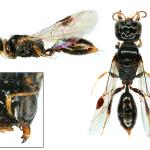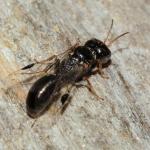Stigmus ater Jurine, 1807
This species had not been recorded in Britain at the time of Richards' (1980) RES handbook, but identification characters are given in Lomholdt (1984). It was first recorded in Britain in 1986 (Allen, 1987), although it may previously have been confused with S. solskyi.
Widespread in the Home Counties and spreading northwards through the central midlands, with scattered records from Dorset to Shropshire, Lancashire, County Durham, Yorkshire and East Anglia.
Lomholdt (1984) describes a very limited distribution in Fennoscandia and Denmark, where it is rare and isolated, and very rare in other parts of central and northern Europe. It occurs eastwards to Kazakhstan.
Listed by Falk (1991) as RDBK (insufficient information) on account of its recent discovery in the country and the lack of detailed records.
Generally found associated with twigs or dead timber, including fence posts where wood-boring beetles have left holes (Falk, 1991). In Essex it has been found exploring north-facing dead wood within standing oak trees within a strip of woodland.
The very limited data set comes mainly from July and August, with a few records extending into September and occasional records from the second half of June.
The cells are said by Lomholdt to be provisioned with aphids, such as Myzus lythri (Schrank).
Lomholdt (1984) states that the nests may be found in stems of plants such as bramble, but all of the author's observations from Essex and Suffolk have been of individuals inspecting small holes left by wood-boring beetles in standing dead wood or damaged trunk sections, all from pedunculate oak. The 1992 records from Buckingham Palace gardens refer to them being taken from old beetle holes in plane trees. In 2014 two specimens were taken in Suffolk from a horizontal roof beam in an open-sided barn, where they were inspecting woodworm holes. Falk (1991) also mentions use of the stems of a variety of shrubs.
No information available.
Lomholdt gives the ichneumonids Perithous scurra (Panzer) (as mediator) and P. divinator (Rossi) and the chalcid wasp Torymus armatus Boheman.
2014



